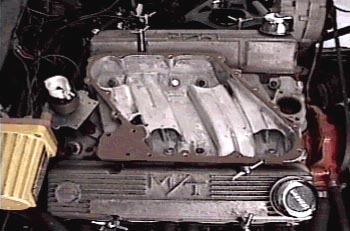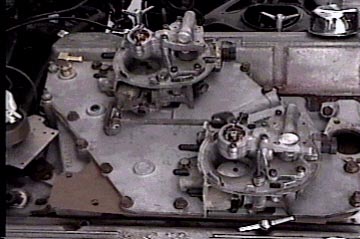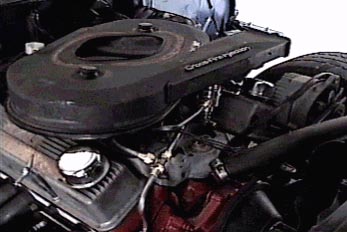Installation
Do yourself a favor and have a look at the orientation of the dizzy, rotor,
and the No 1 plug wire on a running vehicle before installation. What you
see here is wrong. I had never worked on one of these type distributors
before and made a wrong guess. I looked at a 1989 Chevy Truck to get the
correct orientation. It was stickered for 0d base timing. I found out later
that my engine likes 6d, as described in Bruce's Tuning Tips. By using
6d base timing it will still run while in "limp home" mode--like when a
sensor goes bad.

You may also recognize the yellow Accel SuperCoil as being the point
type coil. I've since replaced it with an OEM style coil to narrow my list
of unknown variables during a troubleshooting session, but that wasn't
the problem. I think either will work.
The plenum gasket was not available. I made mine by laying the gasket
material on the manifold plenum and carefully tapping around the edges
with a hammer. The sharp edges of the manifold cut the gasket. A leather
hole punch was used to cut out the bolt holes. It's an old mechanic's trick
and works well.
The brown area of exposed gasket in the lower left is where the EGR
valve would bolt on. I fashioned a plate of steel to block this off after
the photo was taken.
With the gasket in place, the plenum cover and TBIs were installed.
Notice the mechanical linkage between the units and how each throttle body
contains a single injector. Only the rear TBI has a TPS, but both have
an IAC. The front TBI has a fuel accumulator assembly where the rear TBI
has a fuel pressure regulator. As designed by GM the fuel would be fed
to the front unit and then what is normally the return would direct fuel
to the inlet of the rear unit (in-series fuel flow arrangement).
With that configuration the front and rear units saw different pressures
and therefore the injectors were calibrated differently and were not to
be interchanged.

I eliminated the stock fuel pressure regulator and the in-series fuel
flow arrangement and used an aftermarket adjustable fuel pressure regulator
by Mallory. Fuel is routed from the fuel pump to each TBI and then thru
the pressure regulator to the return line. This provides constant and equal
fuel pressure to each TBI. The injectors were replaced by 55lb/hr units
from a '91 Chevy PU with a 350 engine. Once again, these came from the
local Autozone or Advanced Auto Parts store. For the remainder of the fuel
system, steel lines were used with
either the special fuel injection hose or braided steel hose and dual
gates clamps at any location where flex is required. The braided stuff
was used on the pressure side and hose on the return side. This should
be overkill, but I'd rather err on the safe side.
The new plumbing tucks nicely under the air cleaner. A little paint
to the air cleaner and she'll be good as new. The throttle cable
was no longer available from GM. I opted for the long braided steel universal
street rod cable from Lokar--which is still a bit on the short side. I
still have no idea what the bracket looks like either. I made one out of
steel with the help of an Oxy-Acetylene torch.

Special Oxygen sensor bung$ are available from Jeg's and other places. I bought
a pair of anti-fouling 18mm spark plug adapters for $3 and cut off the
bottom with a hacksaw. After welding the bung into the header collector,
adding a coat of John Deere Muffler Paint, and screwing in the O2 sensor
I have something like this...
Installation and wiring of the ECM is an exercise in patience and details.
Painless Wiring
offers a wiring harness without all the extraneous wires which could make
this much easier...if you find writing the check to be easy. I cut a rectangular
hole in the firewall (ouch!) to accomodate the bulkhead connector of my
junkyard wiring harness and allow the ECM to be placed in the interior
of the car. The ALDL connector was mounted under the dash as GM intended
it.
It was quickly noted that I would have to install the VSS for proper
operation (the IAC resets itself when the car reaches 35mph--without this
your chances of ever idling are slim). While looking for the absolutely
quickest way out, I bought Painless Wiring's VSS for TBI cars. Part #60115
was expensive, but braindead easy to install. One day I'll get the
real thing and post an alternative to this pricey stuff.
The best solution for a fuel tank (and pump) would be to find a suitable
donor from a fuel injected car. These would have baffles and an in-tank
pump. I jerry-rigged a baffle for my tank and will share that only if it
turns out to be OK. Confidence in my rig is still low.
Copyright
This information is made available for personal use only and may not be
reproduced without written consent of the author(s). Any attempt to sell
or use this information for personal gain or business purposes is expressly
forbidden.